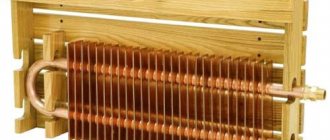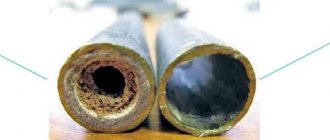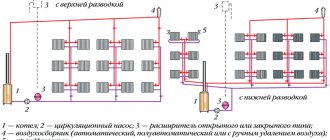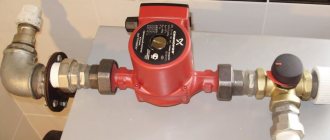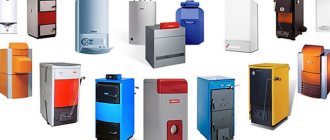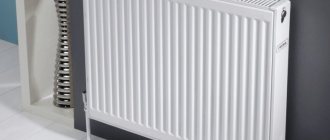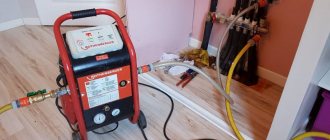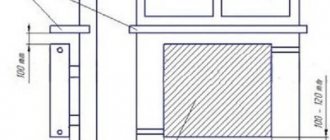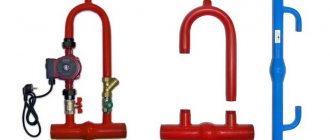Modern heating boilers are in many ways superior to ancient brick stoves, but in some ways they are inferior to them: lacking massive elements, they cannot accumulate heat.
Meanwhile, such an ability, as we will see later, can be very useful and some users, realizing this, equip their boiler with a heat accumulator.
Let's see what role the battery tank plays in the heating system and how you can make it yourself.
Operating principle and purpose
To equip a heating device with a heat accumulator, you don’t need to invent anything special. This role can easily be fulfilled by an integral component of the heating system - the coolant. You just need to significantly increase its volume and slightly modify the connection diagram of the boiler and consumers.
To do this, take a large container covered with a heat insulator (we will henceforth call it a heat accumulator - TA) and connect it to the boiler as if it were a heating circuit. That is, supply and return pipelines are stretched from the boiler to the tank, with the first being inserted into it from above, and the second from below. A circulation pump and a membrane expansion tank are installed on the return line.
We get a small circuit “boiler - TA”. In this case, the heater is faced with the following task: to heat the coolant reserve available in the heating unit to the maximum possible temperature - about 90 - 95 C.
Operating principle of the expansion tank
On the other hand, one or more heating circuits are connected to the TA as if there were a regular boiler instead. In this case, the supply pipeline is connected to the TA from above, and the return pipeline is connected to the bottom. Each circuit has its own circulation pump and expansion tank, as well as a mixing unit.
The latter consists of a jumper between the “supply” and “return”, 3-way valves with thermal heads installed on it and a remote temperature sensor. While the coolant in the circuit is at a sufficiently high temperature, the pump drives it through the jumper in a circle. When the medium cools down, the temperature sensor will operate, which will force the valves to switch so that a certain portion of hot coolant from the heat exchanger enters the circuit.
In this case, part of the cold coolant from the circuit will be discharged into the lower part of the tank. So, over and over again, the automation will mix into the heating circuit exactly the amount of coolant from the battery that is necessary to maintain the required temperature in it.
It is easy to see that the TA simultaneously plays the role of a hydraulic gun. That is, it is possible to connect circuits operating in different temperature conditions, for example, a radiator system and a “warm floor”.
Coolant reserve consumption rate
It is impossible to say exactly how long it will take for the heating system to consume the coolant supply from the buffer tank.
This setting depends on the following factors:
- internal volume of the heat accumulator;
- time of year and outside air temperature;
- degree of heat loss;
- parameters on temperature sensors;
- dimensions of the heated house.
When the heating system is in a passive state, the coolant reserves in the reserve tank may last for several hours or days.
Advantages and disadvantages of a battery tank
Let's now see what the user gains by using heaters with various types of heaters:
With electric boiler
As you know, electric heating is not only superior to any other in terms of ease of use, but can rightfully be considered ideal. Judge for yourself:
- there are no emissions, which means there is no need for a chimney;
- absolutely silent operation;
- heat dissipation power varies from 0% to 100% with constantly high efficiency;
- easy to automate.
But all these advantages are crossed out by one drawback - the high cost of electricity. Anyone who has a TA can significantly reduce the cost of electric heating. The fact is that, along with the usual form of payment for electricity, there is a so-called multi-tariff, which provides for different prices for electricity day and night.
The daytime rate is slightly higher than usual, but the night rate is about 3 times lower. By switching to this form of payment, you can operate the electric boiler only at night, heating the house during the day using the heat accumulated in the heating unit.
In a heating system, the expansion tank for heating is an integral thing. After all, without it, the system would simply collapse. Let's look at this mechanism in detail.
The installation diagram of the circulation pump in the heating system is described here.
You can read more detailed information about heat accumulators in this topic.
With solid fuel boiler
Here the meaning of installing a TA is obvious: the user will be able to add fuel less frequently, which is especially valuable at night. But this is only the “first benefit” that lies on the surface. The fact is that solid fuel boilers operate with maximum efficiency only in rated power mode.
Heat accumulator connection diagram
If the heater is “screwed down” using an air damper, which has to be done during most of the heating season, a whole series of undesirable phenomena immediately appears:
- efficiency drops sharply (incomplete combustion of fuel);
- the formation of soot and toxic condensate increases;
- the exhaust becomes especially toxic due to the increased content of carbon monoxide and other partial oxides, as well as heavy hydrocarbon radicals.
Having a heat storage device, the user has the opportunity, even in the off-season, to operate the solid fuel boiler only at maximum performance: the boiler will absorb excess heat and then gradually release it to the heating system.
With gas boiler
The vast majority of gas boilers operate in a “start-stop” mode, that is, they are periodically turned on to heat the coolant, and then turned off again. Only units with modulated burners (their power is regulated), which are relatively expensive, operate without shutdowns.
The “start-stop” mode is accompanied by temperature changes, which shorten the service life of the boiler elements. Moreover, with a decrease in the load on the heating system (thaw or off-season), the frequency of switching on increases. If there is a TA, the gas boiler will operate stably at rated power, and then turn off for a long time.
Heating a private house with a gas boiler
It should, however, be recognized that you will have to put up with some shortcomings:
- you will need at least two circulation pumps, valves and automation for the mixing unit;
- to accumulate a more or less decent heat reserve, a large volume of coolant is required,
TA usually takes up quite a lot of space and needs a foundation.
How does the heating system work and what is the role of the heat accumulator?
Using a heat accumulator in a heating system with a solid fuel boiler makes it possible to save raw materials up to 50%.
Everything in this scheme is simple, but at the same time very expensive. The small volume of coolant inside the heating system does not allow maintaining a stable temperature for a long time. Accordingly, it must be constantly maintained, otherwise the system will cool down and the room will become cold.
If there is a heat accumulator, this diagram will look different:
- The boiler, while operating, will accumulate heat energy;
- After all the fuel has been extinguished or processed, it will begin to release the accumulated heat to the radiators for a certain time.
Thus, even when the boiler is not working, the house will maintain a stable temperature.
A heating system with a heat accumulator has the following advantages:
- The living conditions in the house are improved, since even after using fuel, the house continues to be heated with hot water;
- A sudden power outage will not prevent you from continuing to heat the water;
- Cold water will not flow into a hot heat exchanger when the pump is turned on suddenly.
The only disadvantages of this system can be the increased cost of installation and certain requirements for the placement of such equipment. But in the end, it more than pays off.
Calculation of the volume of a storage tank for heating
Let us show the calculation using an example with the following initial data:
- Heat loss in the house at the lowest outside temperature is 12 kW.
- The time during which the TA must provide heat to the home in the most severe cold is 5 hours.
- The coolant temperature for which the heating system is designed is +60C.
- The maximum coolant temperature in the heating unit is +90C.
Storage tank
Calculation procedure
We determine the total amount of heat that the TA must store for a 5-hour “duty”:
Q = 12 * 5 = 60 kWh.
Considering that 1 kWh = 3.6 MJ, we get: Q = 60 * 3.6 = 216 MJ.
We calculate the required volume of coolant (water) from the formula:
Q = m*c*(Tmax - Tmin),
Where:
- M is the mass of water;
- C is the heat capacity of water, at t = +60C c = 4182 J/kg*C, at t = +90C c = 4208 J/kg*C, for calculation we take the average value: c = 4195 J/kg*C;
- Tmax and Tmin are the maximum and minimum temperatures of the coolant in the heat exchanger, according to the condition Tmax = +90C, Tmin = +60C.
From this formula we find the required mass of water:
M = T / (c*(Tmax - Tmin)) = 216,000,000 / (4195* (90 - 60)) = 1716.33 kg.
Since 1 kg of water has a volume of 1 liter, we will need a tank with a capacity of 1717 liters or 1.7 cubic meters. m. This volume has a cube with an edge length of about 1.2 m.
The user should take into account that the boiler must have a power 1.5 - 2 times greater than that required to compensate for heat loss in the coldest period, because it will service the heating system and charge the heating equipment at the same time.
Storage tanks from OPEC
In the process of creating its own tanks - heat accumulators, the OPEKS Energy Systems company relies on all its many years of experience and a powerful production base acquired in the interests of producing the highest quality heat exchange equipment on the domestic market. Thanks to these achievements, the OPEKS Energy Systems company produces a large range of capacitive thermal batteries - durable, completely sealed, energy efficient (with minimal specific heat loss) labeled OPEKS-2, with the following parameters and characteristics:
- industrial (volume 30,000 - 60,000 l), household (volume 1000 - 5000 l) and household (100 - 800 l) purposes;
- made of carbon, stainless, enameled steel;
- for use in water supply systems for various purposes: water heating, hot water supply, cold supply, with alternative energy sources.
Manufactured at the same impeccable technological level as branded heat exchange equipment, TM OPEKS heat accumulators perform only at their best in any operating conditions, are characterized by high stability of technical characteristics, compliance with and even exceeding standard service life.
Do-it-yourself recommendations
How to make a battery tank in a heating system with your own hands? Structurally, the TA is a container containing:
- lid;
- fittings for connecting pipelines;
- sleeves for installing a pressure gauge and thermometer;
- safety valve.
Homemade tank
Additionally, the storage tank can be equipped with:
- a coil for heating water for household needs;
- coil for connecting the solar collector;
- tubular electric heaters (TEHs).
An important circumstance: to prevent the coolant from becoming saturated with oxygen, the heat exchanger must be closed. In this case, it will experience load from the pressure developed by the circulation pump.
A rectangular tank can swell under such conditions, so it should be made in the form of a cylinder with a spherical bottom and lid.
Such a container will have to be ordered from a metalworking enterprise, since its manufacture will require rollers and a hydraulic press. For a small volume, you can use a ready-made tank designed for high pressure, for example:
- gas cylinder;
- a receiver from an industrial compressor or from a railway car;
- old boiler;
- container for storing liquid nitrogen.
You can also use a rectangular tank, but then it will need to be reinforced from the inside with connections from a pipe with a diameter of 20 mm.
Did you know that Western European countries are prohibited from using a solid fuel boiler without a heat accumulator? In our country, many people use this equipment. A DIY heat accumulator is a good way to save money and make your heating system safe.
Instructions for making an electric heating boiler with your own hands are given at the link.
Selection of housing material
If the connection diagram provides for several circuits: heating, heated floors, solar collector, etc., then the ratio of diameter and height should be at least 1: 3.
Advantages and disadvantages of a circuit with a heat accumulator:
- Where the area is not gasified, the use of a battery tank in combination with a solid fuel boiler provides significant fuel savings - up to 30%. The heat accumulator for heating smooths out temperature fluctuations and reduces the overall system maintenance time.
- If the standard “solid fuel boiler - buffer tank” scheme is supplemented with a backup line with a gas boiler, then one of the main drawbacks in its operation is eliminated. The fact is that the tank will begin distributing hot water only after it has heated itself, and for such a large volume it will take at least 5-6 hours. In the same scheme, a gas boiler can operate independently from the main line, heating water for heating and DHW. When hot water starts flowing from the tank, the gas boiler will automatically turn off.
- Any scheme with a heat accumulator has one big drawback - the high cost of the battery tank and automation. The calculation is simple: larger tank means higher price. You can make a circuit without expensive controllers, but you will still have to spend a lot on a tank and mixing and pumping units. Of course, over time the equipment will pay for itself.
- Thermal storage is the optimal solution for owners of solar collectors and heat pumps. The consumer “drains” into the buffer tank all the irregularly received heat from these sources plus the excess heat of the boiler, receiving in return hot water for his needs.
How to insulate a heat accumulator?
The most inexpensive, and therefore the most popular, insulation is expanded polystyrene, which in everyday life we are accustomed to calling polystyrene foam.
But in this case it should not be used, since this material, like many other polymers, when heated (starting at a temperature of +80C) releases a noticeable amount of volatile substances harmful to health (the result of the thermal decomposition of polymer molecules).
Of course, in factory-made heat accumulators, as in boilers, polymer thermal insulation is used (usually polyurethane foam), but these devices have a sealed casing, which is quite difficult to make at home.
A more suitable insulation option for TA is mineral wool, the fibers of which are made from basalt or glass. Moreover, it is advisable to use brands in which the role of the binder is not phenol-formaldehyde resin, but acrylic. Examples include URSA PURE ONE and Knauf Insulation insulation.
Connection diagrams
There are many ways to connect a solid fuel boiler with a heat accumulator and a heating system. But they are all derived from the basic circuit shown below. With its help, it is easy to understand how these units work in pairs, and then install everything yourself.
A heat source running on solid fuel has a traditional boiler circuit with a mixing unit, whose task is to prevent the supply of cold coolant to the boiler. Then the supply and return pipelines are connected to the buffer tank, respectively, from above and below. In the same way, a heating system, also equipped with a mixing unit, is connected to the heat accumulator. Its purpose is to maintain the required water temperature in the system, adding part of the hot coolant if necessary.
In fact, the network pump will be more powerful than the boiler pump and here's why. The resistance of the network of pipelines and radiators is higher than 3-5 m of pipe from the solid fuel boiler to the heat accumulator. The unit needs higher power and pressure to overcome this resistance. Therefore, a weaker boiler circuit pump can provide higher flow rates, you just need to configure both units correctly. There are 2 options to resolve the issue:
- When using 3-speed pumps, you can adjust their performance by switching speeds.
- Place a balancing valve at the inlet of the return from the system into the buffer tank, which can be used to make adjustments.
Simultaneous heating of heating devices and layer-by-layer loading of a heat accumulator is possible when the flows inside the tank move horizontally with a slight predominance from the side of the solid fuel boiler. The question arises - how to check this? The answer arises: thermometers must be installed at both return inlets to the tank (as in the diagram) and adjustments must be made by switching pump speeds or rotating the balancing valve
Important condition: the three-way valve of the heating network must be fully opened manually
By adjusting it is necessary to ensure that the temperature at the inlet to the heat accumulator (T1) is less than at its outlet (T2). This means that part of the hot water goes to “charging” the battery. You can learn more about all the points from an expert by watching the video:
Watch this video on YouTube
Alternative scheme
This scheme for connecting a buffer tank and a solid fuel boiler was proposed by one of the participants in the popular forum. Its peculiarity is that in the event of a power outage, the operability of the circuit remains, although you have to pay for this with increased diameters of steel pipes. The figure below shows the connection of a heat accumulator to a closed heating system, but during installation it is better to make it open, as the author himself says.
Briefly, the essence is this: thanks to the T-shaped input on top of the tank, the radiators are simultaneously heated and the thermal accumulator, made by hand, is “charged”. The boiler circuit pump is controlled by a clip-on sensor on the supply line, turning on the unit when it reaches a temperature of 60 °C. The circulation in the network depends on the room thermostat to which the network pump is connected.
Features of operation of solid fuel boilers
The process of burning wood or coal is somewhat more complicated than burning the same methane (natural gas). Methane is a simple inorganic compound that decomposes at high temperatures into carbon dioxide and water with some carbon monoxide. Wood and coal are complex organic substances that, when burned, form several substances and gases, some of which are aggressive. This leaves its mark on the longevity of the heat generator. Individual piping of solid fuel boilers is done in order to create an optimal operating mode and thereby extend their service life.
One of the features of the operation of water heating units that burn solid fuel appears after the firebox is ignited and reaches operating mode. If the installation of heating pipelines is carried out directly to the heating installation and, during heating, cold water is passed through the water jacket of the unit, then condensation will begin to form intensively on the internal walls of the firebox. It reacts with combustion products, mixes with ash and firmly adheres to a metal or cast iron surface. The results are as follows:
- The steel walls of the combustion chamber are corroded by corrosion.
- A cast iron firebox is not as susceptible to corrosion, but its rough surface allows plaque to stick, which is very difficult to remove. The same coating will appear on the walls of the steel chamber.
To successfully combat condensate, it is necessary to install a small circulation circuit with a three-way valve; it is not recommended to connect a solid fuel boiler to the heating system directly.
Another feature of the operation of wood heating systems is inertia. When the water temperature in the system is sufficient, the automation closes the access of air to the firebox and stops the process. Nevertheless, combustion continues for some time, the coolant temperature exceeds the set one. The same phenomenon is observed when the circulation pump stops as a result of a power outage. Water in the jacket can boil, forming steam, and destroy the jacket or rupture pipes. To avoid this, a safety group with a relief valve set to a certain critical pressure is installed on the supply pipe or directly in the boiler water tank.
How to choose the right model
Without a buffer tank, the coolant temperature drops immediately after the boiler is turned off. The main criterion for selecting a model: calculation of the heat accumulator. The formula used is:
m is the mass of the coolant,
Cp is the heat capacity of the coolant,
T2 average final temperature of water in the tank,
T1—average initial temperature.
Experts from a water and heating supply company will help you accurately calculate the volume and other parameters, or you need to independently set the starting indicators on an online calculator and get the recommended data
Take into account the power of the boiler. pressure inside the system, number of radiators, cross-section and diameter of pipes, type and volume of coolant
The storage tank is selected taking into account the following factors: material of construction, volume, power of the device, coolant pressure in the system, functionality. Manufacturers offer heat accumulators whose walls are made of black, carbon steel or stainless steel. They are resistant to corrosion and contamination, require less cleaning, and work for a long time.
- The heat accumulator of the EAB series made of black carbon steel with an internal boiler made of food-grade stainless steel is designed for a system operating at a pressure exceeding 0.3 MPa. The kit includes heat exchangers of a simple or block type. Has a magnesium anode that protects against scale. Suitable for additional connection of solar collectors. Used for flow heating.
- The heat accumulator for heating EA is a device with and without heat exchangers. The material is steel, painted on the outside, the thermal insulation is made of artificial blue or red leather. Additionally, you can connect the drive to a solar battery. The models are designed for heating running water, as well as circulating coolant through the system from the tank.
- Heat storage for heating type EAI is used when connecting two or more heat sources, capacity 350 - 3500 liters.
The modern heat accumulator has antibacterial protection and is designed for retrofitting Tenami and connecting block heat exchangers.
For a system with an internal pressure of more than 4 bar, choose a tank with thickened walls and torispherical tight lids.
The role of the hydraulic accumulator in the water supply network
It would seem that the device simply passes water through itself. Could you do without it? In fact, it is with the help of a hydraulic tank that stable pressure is maintained in the water supply system.
If for any reason the voltage in the electrical network is lost, a small “emergency” supply of water in the tank will help solve priority economic problems.
Let us clarify the list of advantages that this fairly simple device provides:
- Premature pump wear. There is a certain supply of water in the membrane tank. It satisfies the primary needs of cottage owners. And only when the supply runs out will the pump turn on. It should be noted that all pumps have a turn-on rate of an hour. If there is a hydraulic accumulator, this figure will not be exceeded, and the unit will last longer.
- Stabilization of pressure in the system. If you turn on two taps at the same time, for example in the bathroom and in the kitchen, pressure changes can affect the water temperature. This is very unpleasant, especially for those household members who are taking a shower at this moment. Thanks to the hydraulic accumulator, such misunderstandings can be avoided.
- Water hammer. These phenomena, which can damage the pipeline, can occur when the pump is turned on. With a hydraulic tank, the risk of water hammer is virtually eliminated.
- Water supply. In a country house, the problem of water supply is especially acute. If there is a sudden power outage and the pump cannot perform its functions, then it is no longer necessary to store a supply of water in a bucket or other container to solve urgent problems. It is available in the hydraulic accumulator tank and is regularly updated.
Obviously, the presence of this device in a water supply system independent of centralized networks is not accidental. It is necessary and useful.
The hydraulic accumulator in the water supply circuit performs a number of significant functions: it protects equipment from water hammer, provides a supply of water, and creates conditions for automating its intake.
When a hydraulic tank is not needed
In irrigation systems, a hydraulic accumulator is not needed, since when the tap is constantly open, the pump will operate without turning off. If there is a storage capacity in this scheme, the equipment will be turned on frequently, which will lead to premature depletion of the resource.
When purchasing a pump with an automatic system that involves smooth engine starting, a hydraulic pump is also not needed. The pipes are not at risk of water hammer, since the fluid flow moves slowly.
What it is?
But what is this device? In essence, this is a source of electrical energy, but only a secondary one, since the main task, as already mentioned, is to start the engine.
Yes, the battery supports the electrical equipment found in any car, but only in a secondary role. In reality, they are powered by a generator while the car is moving. But when the vehicle is immobilized and the engine is not running, then the load from the on-board network falls on the battery. This is actually why it is not recommended to listen to music for a long time when the car is just standing still.
In the middle of the 20th century, internal combustion engines managed just fine without batteries. This mainly applied to motorcycle engines. Muscular force was used to launch them. Then the generator provided energy. Does each of us remember how the Izh family motorcycle started up?!
After some time, manufacturers began to equip vehicles with a large number of electrical appliances. And each time their number only increases. Therefore, recharge from the battery is very useful. Perhaps in a few years, most vehicles will switch to an on-board network with a nominal value of 24 volts, instead of the usual 12. Although some Mercedes cars have already done this.

